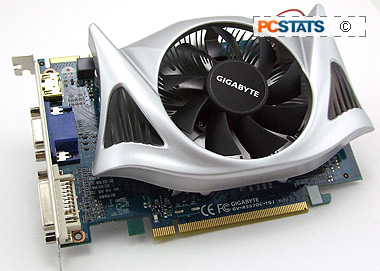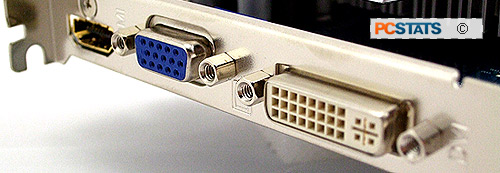 STALKER: Call of Pripyat - DX11 STALKER: Call of Pripyat - DX11 |
Source: GSC |
|
Stalker: Call of Pripyat benchmark is
based on one of the ingame locations. The testing process includes four stages,
those utilizing various weather and time of the day settings (day, night, rain,
bright sun). In order to test your system thoroughly the benchmark is provided
with a number of presets and options including different versions of DirectX
(9.0, 10.0, 11), screen resolutions, antialiasing etc, all at your disposal.
 STALKER Call of Pripyat
- Ultra / DX11 / 4xMSAA/HDAO STALKER Call of Pripyat
- Ultra / DX11 / 4xMSAA/HDAO |
| Sun Shafts Test 1600x1200 |
Points |
Ranking |
 Gigabyte
GV-R567OC-1GI Gigabyte
GV-R567OC-1GI |
10.056 |
   |
| Sun Shafts Test 1900x1200 |
Points |
Ranking |
 Gigabyte
GV-R567OC-1GI Gigabyte
GV-R567OC-1GI |
8.47 |
   | |
Stalker: Call of Pripyat is one of the first DirectX 11
benchmarks, and it proves to be a punisher for the GV-567OC-1GI. This test is
designed for high-end flagship videocards, so pitting it against a $100
mainstream videocard isn't entirely fair.
Now let's wrap all of this up, conclusions are next!
 Conclusion:
Just Missing the Sweet Spot?
Conclusion:
Just Missing the Sweet Spot?
ATI's Radeon HD 5670 brings DirectX 11 technology into
the mainstream. In just a few months the "Evergreen" RV8xx architecture has
moved from the ultra-high-end all the way to mainstream computer users.
Technically this videocard can do everything the big
boys can do: the Gigabyte GV-567OC-1GI's 'Redwood" RV810 GPU is capable of
DirectX 11 tricks like tessellation and compute shading, which will start making
major appearances later on in 2010. Tessellation especially will become an
important eyecandy feature that allows much more detailed character models
and environments in videogames; think of it as bump-mapping's more
sophisticated, more attractive older sister.
However while the Gigabyte GV-567OC-1GI videocard and
its 1GB of GDDR5 memory certainly has the theoretical capability of running
next-generation DirectX 11 graphic effects, in real-world usage it's simply not
fast enough for today's games.
The RV810 'Redwood' GPU has fewer stream processors,
texture units and raster operators than last generation mainstream and mid-range
videocards like the Radeon HD 4770 and Radeon HD 4850, which can also be found
for around the $99 USD ($110 CDN / £65GBP) you'd pay for
Gigabyte's Radeon HD 5670 GV-567OC-1GI videocard.
 Even with a
785MHz clock speed (Gigabyte overclocks the GPU core clock speed an extra
10MHz, the default clock speed is 775MHz), and 1GB of GDDR5 memory operating at
an effective 4000MHz, the GV-567OC-1GI videocard can't keep up with its peers
from the Radeon 4000-series.
Even with a
785MHz clock speed (Gigabyte overclocks the GPU core clock speed an extra
10MHz, the default clock speed is 775MHz), and 1GB of GDDR5 memory operating at
an effective 4000MHz, the GV-567OC-1GI videocard can't keep up with its peers
from the Radeon 4000-series.
Most of the more intensive games on the PCSTATS
benchmarking suite had to have graphical settings, resolution and anti-aliasing
turned down substantially in order to achieve playable frame rates.
All of this put together makes the GV-567OC-1GI
difficult to recommend. If you're looking for a modestly priced videocard for
lightweight gaming, you're better served getting Gigabyte's own Radeon HD 4770 or a Radeon HD 4850. If you just need a
videocard for HDMI video output you can grab a Radeon HD 4350 for around $50. Finally, if you really
want to see DirectX 11 effects in your videogames, it's best to invest a bit
more cash into a Radeon HD 5770 or 5850 graphics card so you can play
games at acceptable frame rates.
Discuss this videocard in the PCSTATS
Forums. Find out about this and many other reviews by joining the
Weekly PCstats.com Newsletter
today! Catch all of PCSTATS latest reviews right here.
Related Articles
Here are a few other articles that you
might enjoy as well...
- Gigabyte GV-N26SO-896I Geforce GTX 260 Videocard Review
-
Gigabyte GV-N285OC-2GI Geforce GTX 285 2GB Videocard
Review
- ASUS
EAH4890 TOP HTDI/1GD5/A Radeon HD 4890 Rev. B Videocard Review
- ASUS
EAH4770 FML/DI/512MD5/A Radeon HD 4770 Videocard Review
- Gigabyte GV-N26OC896H-GA Geforce GTX260 Core 216 Videocard
Review
- ASUS
EN9400GT-1GB Geforce 9400GT Half-Height Videocard Review
- Gigabyte GV-R435OC-512I Radeon HD 4350 Half-Height Videocard
Review
- ASUS
EN9600GT DI/512MD3/A Geforce 9600GT Rev.B Videocard Review
- Sparkle GTX260 Core 216 GeForce GTX 260 Videocard
Review
